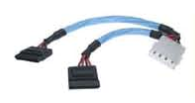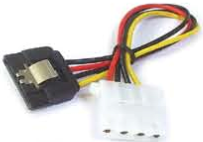
 Lan Cable
(29)
Lan Cable
(29)
 Patch Cord
(25)
Patch Cord
(25)
 Optic Fiber
(74)
Optic Fiber
(74)
 Networking Accessories
(424)
Networking Accessories
(424)
 Cable Management
(16)
Cable Management
(16)
 Networking Tools
(206)
Networking Tools
(206)
 Computer Cable
(434)
Computer Cable
(434)
 HDMI Cable
(424)
HDMI Cable
(424)
 USB Cable
(49)
USB Cable
(49)
 Computer Connector
(50)
Computer Connector
(50)
 Coaxial Cable
(1)
Coaxial Cable
(1)
 Alarm Cable
(30)
Alarm Cable
(30)
 Speaker Wire
(8)
Speaker Wire
(8)
 CCTV Accessories
(24)
CCTV Accessories
(24)
 Iphone Cable
(15)
Iphone Cable
(15)
 Computer Peripherals
(78)
Computer Peripherals
(78)
 New Products
(43)
New Products
(43)
Inner Power Cable


SATA (Serial Advanced Technology Attachment) devices feature separately cabled connections for power and data transfer. Unlike the previous standard SATA power cables have more pins, a lower profile and options for lower voltage. These features support better power transfer while allowing for more energy-efficient operations.
Pins: The first distinction of the SATA is the number of pins. The standard produced by the SATA-IO (Serial Advanced Technology Attachment-International Organization) sets a 15-pin design for all SATA power cables. This allows for even distribution of power within three voltage groups. These specifications are detailed in revision 3.0 of the SATA specifications guide.
Voltage: SATA power cables support three voltages. Pins 1 to 3 support 3.3V, the 7th through 9th terminals handle 5V and the final three pins transfer 12V. The 4 to 6 and 10 to 12 pins are exclusively for grounding. One pin in each group is longer than the rest to limit the inrush current during hot-swapping. Hot-swapping enables you to unplug SATA devices from your computer without a full system shutdown. The support for lower voltage enables energy efficient devices to function with less electrical waste.
Construction:SATA power cables feature a wide, wafer-style head. The plug is made of molded plastic with a distinct shape, which minimizes the risk of improper insertion. The terminal pins are seated within the head to prevent unintentional contact. Depending on the manufacturer of the power cable, pins may be solid or plated metal. Common materials for this purpose include brass, bronze, copper, tin, gold and nickel alloy.
Serial ATA Power splitter cable, sata15P, power cable can not only transfer data but also provide power for computer
The serial ATA, or SATA computer bus, is a storage-interface for connecting host bus adapters to mass storage devices such as hard disk drives and optical drives. The SATA host adapter is integrated into almost all modern consumer laptop computers and desktop motherboards.
Serial ATA was designed to replace the older ATA (AT Attachment) standard (also known as EIDE). It is able to use the same low level commands, but serial ATA host-adapters and devices communicate via a high-speed serial cable over two pairs of conductors. In contrast, the parallel ATA (the redesignation for the legacy ATA specifications) used 16 data conductors each operating at a much lower speed.
SATA offers several compelling advantages over the older parallel ATA (PATA) interface: reduced cable-bulk and cost (reduced from eighty wires to seven), faster and more efficient data transfer, and hot swapping.
SATA POWER CABLE (SATA 7PIN + 15PM+15PM Cable SATA Power Cable)
This straight-angle serial ATA cable (SATA CABLE) from Tongrun creats a great internal-CPU connectively solution use the newest ATA technology. The serial ATA cables will reduces your power consumption, compared to a standard parallel ATA cable. Will increase transfer and dramatically enhancing airflow within CPU. It offers ideal support for high-end, heat generating applications such as going, Full-motion video and multimedia. By reducing your PC's internal temperature. potential damage to your systems performance and lifespan can be averted
1. Reduces clutter and overheating with CPU
2. Meets serial ATA standards and maintain software compatibility with current operating systems
3. Installs ad handles easier than a flat ribbon cable
4. Comes with lifetime Warranty